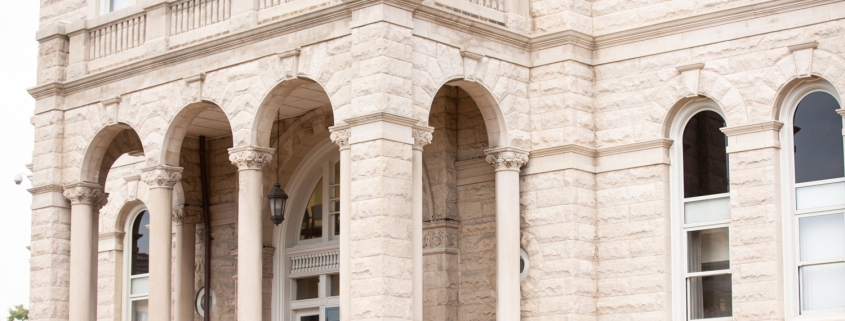A long-distance call: Rule will allow remote testimony by video
Partner C. Frank Hilton chaired the Boyd-Graves committee that recommended rules to guide audio-visual testimony. See article below featured in Virginia Lawyers Weekly.
February 24, 2020 – By: Peter Vieth
“A long-distance call: Rule will allow remote testimony by video”
A new rule promises to open opportunities for Virginia lawyers to present trial witnesses by video from distant locations. Witnesses will be allowed to testify by audio-video links at civil trials under the rule that takes effect March 15.
The rule may find common use in personal injury cases. The language suggests a judge should normally allow a treating medical provider to testify by video unless there is good cause to require in-person testimony. But the rule says parties and experts should be allowed to appear remotely only under “exceptional circumstances.”
The Supreme Court of Virginia approved Rule 1:27 on Jan. 9 after two years of study by a Boyd-Graves Conference committee and preparation of a draft by the Advisory Committee on Rules of Court. It applies only to civil actions in circuit court.
Framework of standards
Besides its preference for allowing remote testimony of doctors and others providing medical care for a party, the rule sets other standards for considering long-distance witnesses.
The remote testimony “should” be allowed for any witness if all parties consent. The trial judge also “should” allow the video link if a lay witness is more than 100 miles away or out of state.
A judge “may” permit distant testimony of a non-party lay witness if good cause exists. A higher standard applies for party or expert testimony. Under “exceptional circumstances,” the court “may” permit video testimony of party and expert witnesses.
The rule provides a non-exhaustive list of considerations:
1. The age of the witness, and whether the witness has disabilities or special needs,
2. Whether translation may be required,
3. Procedures available for handling of exhibits,
4. Mechanisms for making and ruling upon objections – both within and outside the hearing of the remote witness,
5. Procedures for sidebar conferences between counsel and the judge,
6. Mechanisms for the witness to view counsel, the parties, the jury and the judge,
7. Practical issues such as the size, number and location of display screens at both locations,
8. Any requirements for camera angle, camera movement or point of view; any picture-in-picture requirements,
9. How to attain the required encryption,10. Creation of the record of the testimony and
11. Any necessary limitations or conditions on those who may be present with the witness and whether those persons must be identified before the testimony begins.
The responsibility for all arrangements falls on the party offering long-distance testimony. Failure to ensure everything works will not be grounds for continuance under the rule.
“The parties bear the risk,” explained C. Frank Hilton of Harrisonburg, who chaired the Boyd-Graves committee that recommended rules to guide audio-visual testimony.
If there is a courthouse power failure or similar malfunction, the judge is authorized to grant a continuance or other relief, under the rule.
Existing statutes
The study committee found three current statutes that already offer guidance for lawyers considering use of remote testimony. Va. Code § 17.1-513.2 applies to civil proceedings in circuit courts, § 16.1-93.1 applies to civil proceedings in district courts and § 19.2-3.1 sets standards for audio-video appearances generally for pre-trial matters.
Those using the remote link must be able to simultaneously see and speak to one another, the signal must be “live, real time” and the signal must be secure from illicit interception.
Section 19.2-3.1 says use of two-way remote links is subject to any other specifications “promulgated by the Chief Justice of the Supreme Court.” The new rule is a response to that invitation, according to the advisory committee.
The study committee found courts were taking different approaches to use of electronic connections for remote witnesses.
“Telephone testimony was happening at all levels, including J&DR courts,” Hilton said.
The committee took the stance that, if audiovisual testimony was going to happen, “let’s get out in front of this and do it right,” Hilton said.
Expert use discouraged
Some of the concerns about remote expert witnesses recently emerged in a medical malpractice action in Richmond Circuit Court. A plaintiff’s attorney proposed to offer audiovisual testimony at trial from a reviewing physician in the state of Washington offered as a fact witness. It appeared the doctor’s testimony would underpin the plaintiff’s theory of malpractice.
In a 2019 motion in limine, the defendant physician complained his lawyers would be unable to observe the witness’ mannerisms, gestures and affectations. The lawyers would be unable to hand the witness documents or other materials.
To force the defense team to submit cross-examination materials in advance “negates the entire purpose of cross-examination,” the motion stated. The case resolved before a judge could address the issue.
But parties and experts are special cases under the new rule, Hilton explained.
“We came to agreement that parties and experts more often than not ought to be in the courtroom,” Hilton said.
Remote testimony is best used for non-critical witnesses, such as medical records custodians, Hilton said.
“This is the perfect thing for that.”
Consent forms
Out-of-state witnesses may be leery about the consent form they will have to sign.
“While the consent requirement may limit the number of remote witnesses willing to provide distance-testimony using this procedure, since it highlights the witness’s exposure to perjury, contempt or other orders of the Virginia trial judge, the Advisory Committee concluded that having such safeguards will be needed to assure the integrity of the testimonial process for our courts,” the committee stated in 2019.
“The hope is that enough situations will arise where the remote witness procedure is used that – over the coming years – Virginia litigators and judges will gain experience such that the rules governing this process can be adjusted to increase convenience and reduce burdens on all parties and the court.”



